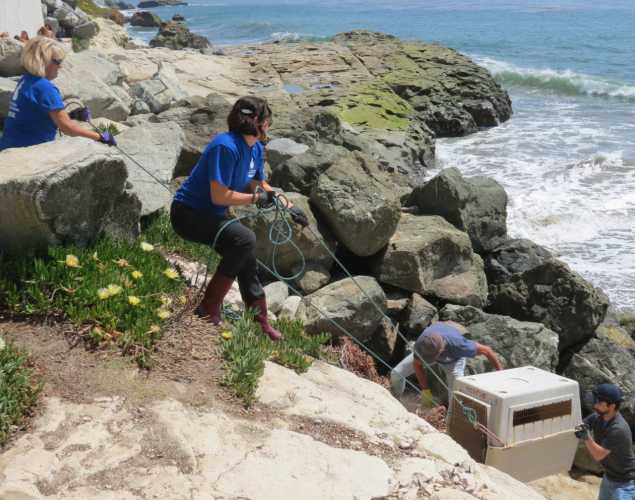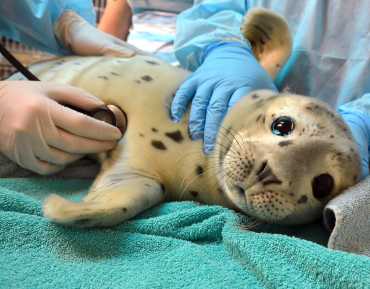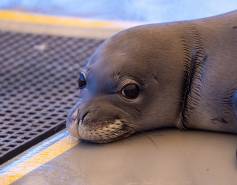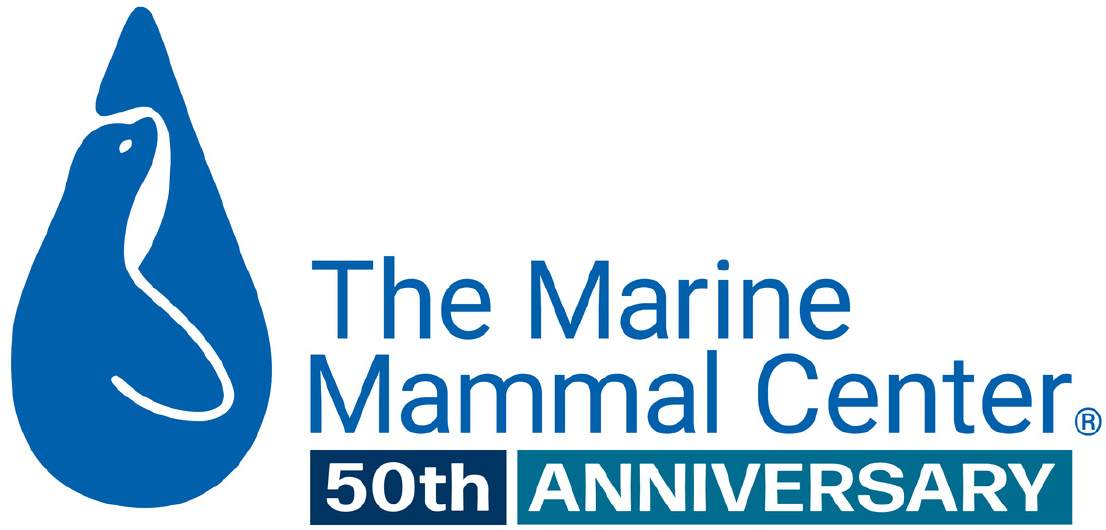
The Marine Mammal Center reports high levels of marine mammal disturbance in Central and Northern California for third year in a row
The Marine Mammal Center reports high levels of marine mammal disturbance in Central and Northern California for third year in a row
Data shows 26 percent of marine mammal patients rescued by the Center in 2024 experienced some form of human or dog disturbance on local beaches
The Marine Mammal Center, the world’s largest marine mammal hospital, reports that internal data gathered over the last three years on the impact of human-wildlife interaction highlights a complex and concerning threat for marine mammals along 600 miles of California coast and inland areas.
The Center’s Electronic Animal Record System Team identified that wildlife disturbance by people or dogs was reported (or noted) in more than 250 cases, equating to 26 percent of all marine mammals rescued and admitted to the Center’s Sausalito hospital in 2024.
Importantly, the disturbance data shows consistency for three years running (26-30% of annual cases), providing a baseline that is critical for highlighting the severity of the issue in various counties and refining public calls to action to create positive behavior change.
Of the more than 250 cases of disturbance last year, people getting too close to sick or injured marine mammals was again the most common form of behavioral disturbance the Center's experts documented. This behavior, which involves crowding around an animal and not giving it appropriate space, can lead to increased stress levels for the animal, separate moms from their pups, and disrupt response operations by forcing animals back to the water or to alternate locations -- hindering the Center’s goal to give these sick or injured marine mammals a second chance at life. While the Center’s experts recognize that disturbance is often not the main reason these marine mammals are rescued, these types of disruptive and dangerous behaviors are preventable.
“Our work is focused on finding solutions and dedicating resources to address the complex factors behind marine mammal disturbance along our vast 600-mile California response range,” says Adam Ratner, Director of Conservation Engagement at The Marine Mammal Center. “Our research shows that the overwhelming majority of people are well intentioned and want to help these animals, but they don’t know how and often take the wrong action. We want to empower both tourists and locals alike to take the action that’s best and safest for marine mammals and people alike.”
The Center utilizes a multi-pronged approach to raise shared awareness, including utilizing new research within social science, communication and behavior change, to address the issue of human-wildlife interaction. These initial efforts have identified factors behind specific beachgoer behavior and are part of a wider plan to engage with tourists and small businesses in key negative human interaction hot spot areas with information about how to safely share our shores and local waterways with marine wildlife.
Utilizing both in-person interviews with beachgoers and online surveys with residents and tourists, two core motivations were identified and serve as the baseline for outreach efforts. The first archetype, “the wildlife protector,” mostly represents a local individual trying to help because of their passion for wildlife but can unfortunately take actions that result in more harm for the animal. The other identified archetype, “the experience seeker,” largely represents a tourist seeking out an experience with marine life and is heavily influenced by what they see on social media.
In Marin County specifically, severe disturbance cases with fragile harbor seal and elephant seal pups stood out to experts reviewing the data. Despite a moderate to low number of overall disturbance cases when compared to other counties, half of Marin County’s cases fell into the “severe” category that included physical touching, pouring water on, feeding and moving by people. These behaviors, while often well-intentioned, can lead to increased stress, and life-threatening separations for a dependent harbor seal pup.
Annabelle, a male harbor seal pup rescued on March 26, 2024, near the Sausalito Yacht Club, is a standout case that highlights the impact of disturbance. Trained volunteer responders who arrived on the scene noted the prematurely born animal was vocalizing as multiple people were surrounding it with their barking dogs and taking photos. Given this high degree of human and dog activity nearby, there was no chance of this pup reuniting with their mother and a rescue was immediately initiated. Sadly, Annabelle was humanely euthanized in care by veterinary experts a few days later given her poor prognosis due to cardiac arrhythmia, pneumonia and malnutrition.
Similar to 2022 and 2023, last year’s data also reveals that these incidents were just as prevalent in the summer and fall as they were during harbor seal and elephant seal pupping season in the Spring. It is important to note that a major outbreak of domoic acid toxicosis in San Luis Obispo County contributed to an outsized share of the number of cases in that response region. More than 200 disoriented, lethargic, and seizing sea lions were rescued on busy public beaches in August and September last year.
As the world’s largest marine mammal hospital, The Marine Mammal Center is so thankful for everyone that wants to help protect and care for our local marine mammals. Rather than try and help the animals directly, which can unintentionally cause more harm than good, please follow these guidelines:
- Keep Your Distance. Give marine mammals space to rest by enjoying them from a safe distance of at least 150 feet (that’s half a football field) both on local beaches and in the water, and keeping dogs on a leash.
- Call the Experts. If you see a marine mammal in distress, do not intervene. Instead, call The Marine Mammal Center’s hotline at 415-289-SEAL (7325). Our experts will monitor the animal and, if necessary, send trained responders to rescue it safely.
- Use Your Zoom. It’s OK to take photos and admire the animals, but if an animal reacts to your presence, then you’re too close. No SEAL-FIES please!
To learn more about the impact of marine mammal disturbance visit the Center’s website or check out the latest Sentinels of the Sea podcast episode highlighting the issue.
For more information or to set up an interview on this topic, please contact us at media@tmmc.org.
For breaking news about our whale responses as well as additional press materials, bookmark MarineMammalCenter.org/whale-stranding.
Yes, I want to save a life!

Yes, I want to save a life!
You’ll be giving sick and injured animals the best possible care at the Center’s state-of-the-art hospital. With your gift today, you are giving a patient a second chance at life in the wild.
See Our Latest News
{"image":"\/Animals\/Patients\/Hawaiian monk seals\/2025\/cropped-images\/d-ru28release-exam-at-ke-kai-ola111025photo-by-giancarlo-rulli-c-the-marine-mammal-center-noaa-permit-24359-0-0-1270-992-1764620886.jpg","alt":"","title":"Bird Flu Vaccine Trial Offers Hope for Protecting Hawaiian Monk Seals","link_url":"https:\/\/www.marinemammalcenter.org\/news\/bird-flu-vaccine-trial-may-offer-hope-for-protecting-hawaiian-monk-seals","label":"News Update","date":"2025-12-01 08:13:00"}

Bird Flu Vaccine Trial Offers Hope for Protecting Hawaiian Monk Seals
December 1, 2025
Read More{"image":"\/Animals\/Patients\/Hawaiian monk seals\/2021\/hms-pp08-by-sheila-latta-c-the-marine-mammal-center-noaa-permit-18786.jpg","alt":"Hawaiian monk seal","title":"The New York Times: Inside the Bird-Flu Vaccine Trial for Monk Seals","link_url":"https:\/\/www.marinemammalcenter.org\/news\/the-new-york-times-inside-the-bird-flu-vaccine-trial-for-monk-seals","label":"In the News","date":"2025-12-01 01:00:00"}

The New York Times: Inside the Bird-Flu Vaccine Trial for Monk Seals
December 1, 2025
Read More{"image":"\/Animals\/Wild\/Sea otter\/so-wild-morro-bayphoto-c-brian-simuro-20.jpeg","alt":"Sea otter and pup","title":"Watch a Sea Otter Pup Reunite With Its Mother","link_url":"https:\/\/www.marinemammalcenter.org\/news\/watch-sea-otter-pup-reunite-with-its-mother","label":"News Update","date":"2025-11-14 10:35:41"}

{"image":"\/Animals\/Wild\/Sea otter\/sea-otter-photo-c-brian-simuro.jpeg","alt":"Sea otter","title":"AP News: Baby sea otter is reunited with mother in central California after dramatic rescue","link_url":"https:\/\/www.marinemammalcenter.org\/news\/ap-news-baby-sea-otter-is-reunited-with-mother-in-central-california-after-dramatic-rescue","label":"In the News","date":"2025-11-14 09:46:34"}

AP News: Baby sea otter is reunited with mother in central California after dramatic rescue
November 14, 2025
Read More


